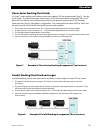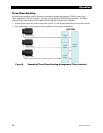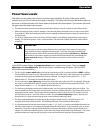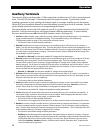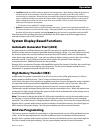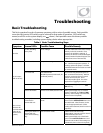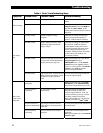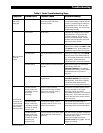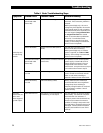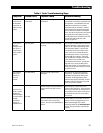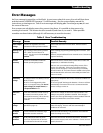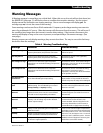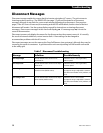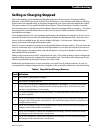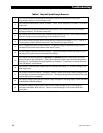
Troubleshooting
900-0114-01-00 Rev A 33
Table 4 Basic Troubleshooting Steps
Symptom Unusual LEDs Possible Cause Possible Remedy
Reduced power
sold to the
utility grid
None AC source voltage is driven high
when the inverter sells large
amounts of power.
When the inverter senses a rise in grid
voltage while selling, it reduces the sell
current, to avoid forcing the voltage to
unacceptable levels. Check AC input
voltage while selling. The inverter may
be behaving correctly.
No AC IN LED No AC input. Check the AC voltage on the inverter’s
input terminals. If not present, the
problem is external. If present, the
inverter could be damaged. Contact
OutBack Technical Support (see inside
front cover of this manual).
AC IN LED flashes Inverter set to disconnect from AC. MATE system display only: Change AC
Input Control setting from
DROP
to
USE
with
AC IN
hot key. (If this setting was
intentional, then no action is required.)
AC IN LED flashes HBX mode has disconnected from
AC.
MATE system display only: Check
AC IN
hot key screen to see if HBX mode is in
use. If activated prematurely, check the
HBX settings. (If this setting was
intentional, then no action is required.)
AC IN LED flashes Grid use function has disconnected
from AC.
MATE system display only: If activated
prematurely, check both
ADV/MATE/GRIDUSE
menu settings
and MATE clock settings. (If this setting
was intentional, then no action is
required.)
Will not connect
to the AC
source.
AC IN LED flashes
AC source does not meet
requirements.
MATE system display only: Check
STATUS/FX/DISCON
for the reason for
disconnection. If unit never originally
connected, check Warning menu.
Confirm source voltage and frequency.
AC IN LED switches
between continuous
and flashing. Inverter
LED remains
illuminated.
Inverter’s output has been
connected to its input. Voltage
shifts are the result of trying to
match its own voltage.
Disconnect wires from either inverter’s
AC input terminals or AC output
terminals, or both. If problem
immediately disappears, it is an external
wiring issue. The inverter’s AC HOT IN
and AC HOT OUT must remain isolated
from each other.
AC IN LED switches
between continuous
and flashing. Inverter
LED turns on and off
with each cycle.
Low AC input voltage. Can be
caused by weak AC source, or by
faulty input connection.
Test AC HOT IN and NEUTRAL IN
connections with AC voltmeter. If low or
fluctuating, this is an external problem.
Inverter clicks
repeatedly. AC
output voltage
rises or drops to
unusual levels
with every click.
AC IN LED switches
between continuous
and flashing. Inverter
LED turns on and off
with each cycle.
(Generator only)
Inverter has been set to sell to utility
grid but has been connected to a
generator.
Unit will drive the generator voltage up
to disconnection, then reconnect to the
generator and try again.
MATE system display only: Set
ac
transfer control
menu to
gen.
This will
keep it from selling.



